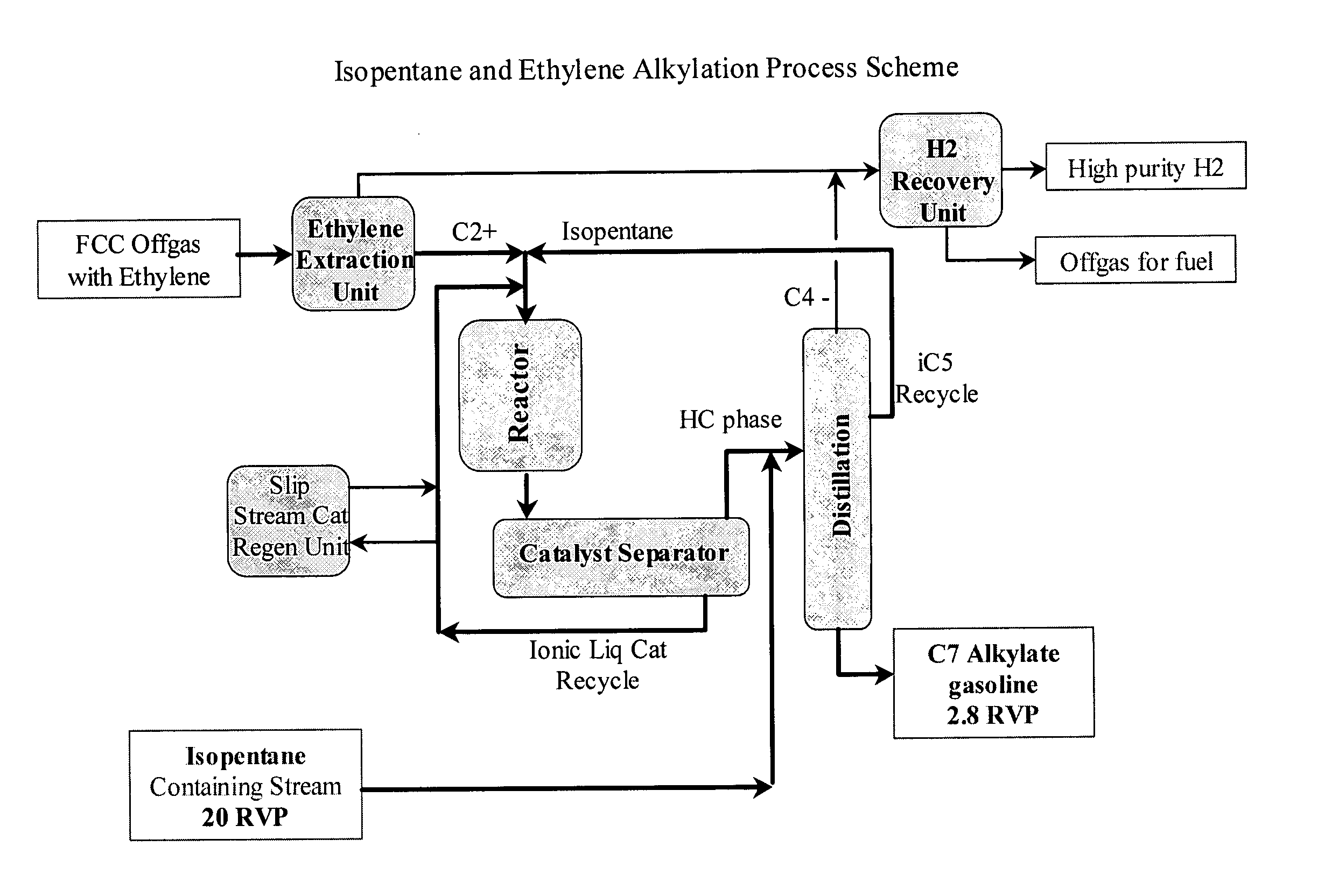Integrated alkylation process using ionic liquid catalysts
a technology alkylation process, which is applied in the direction of organic chemistry, hydrocarbon oil treatment products, fuels, etc., can solve the problems of serious problems such as the inability to find uses for isopentane by-products, the significant amount of isopentane produced by refineries, and the inability to meet the requirements of ionic liquid catalyst requirements, etc., to achieve the effect of improving the operating efficiency of the refinery, reducing fuel gas production
- Summary
- Abstract
- Description
- Claims
- Application Information
AI Technical Summary
Benefits of technology
Problems solved by technology
Method used
Image
Examples
example 1
The Preparation of N-Butyl-Pyridinium Chloroaluminate Ionic Liquid
[0046] N-butyl-pyridinium chloroaluminate is a room temperature ionic liquid prepared by mixing neat N-butyl-pyridinium chloride (a solid) with neat solid aluminum trichloride in an inert atmosphere. The syntheses of butylpyridinium chloride and the corresponding N-butyl-pyridinium chloroaluminate are described below. In a 2-L Teflon-lined autoclave, 400 gm (5.05 mol.) anhydrous pyridine (99.9% pure purchased from Aldrich) were mixed with 650 gm (7 mol.) 1-chlorobutane (99.5% pure purchased from Aldrich). The neat mixture was sealed and let to stir at 145° C. under autogenic pressure over night. Then, the autoclave was cooled down to room temperature, vented and the resultant mixture was transferred to a three liter round bottom flask. Chloroform was used to rinse the liner and dissolve the stubborn crusty product that adhered to the sides of the liner. Once all transferred, the mixture was concentrated at reduced pr...
example 2
Batch Alkylation Run Procedure
[0047] Isopentane and ethylene batch alkylation was typically run at 50° C. with paraffin / olefin molar ratio of about 4. Under nitrogen atmosphere in a glove box, an autoclave vessel was charged with ionic liquid catalyst and anhydrous isopentane. The autoclave was then sealed and transferred to a hood and affixed to an overhead stirrer. Then, ethylene gas was introduced to the vessel. The autogenic pressure of the vessel usually rises to 2000 kPa to 24000 kPa depending on the amount of ethylene gas introduced into the autoclave. Once the reaction begins stirring (˜1200 rpm), the pressure quickly drops down to ˜900 kPa to 1100 kPa. The reaction is allowed to continue and stir until the pressure drops to 0 kPa to 70 kPa. Then, the stirring is stopped and the heating mantle is quickly removed. The autoclave is then cooled down to room temperature using a cooling coil. Then, a gas sample was drawn and the reactor is vented and weathered to relieve the sys...
example 3
Batch Alkylation of Isopentane in Butylpyridinium Chloroaluminate without Applying Any Additional Pressure (Only the Autogenic Pressure of the System)
[0048] Ethylene (9.5 gm) was alkylated with isopentane (103 gm) in 20 gm butylpyridinium chloroaluminate ionic at 50° C. and the autogenic pressure in a closed 300 cc autoclave fitted with an overhead stirrer and a cooling coil. The reaction was allowed to stir at ˜1200 rpm until no significant drop in pressure was noticeable. Table 1 below shows the reaction results.
PUM
| Property | Measurement | Unit |
|---|---|---|
| vol % | aaaaa | aaaaa |
| molar ratio | aaaaa | aaaaa |
| atmospheric pressure | aaaaa | aaaaa |
Abstract
Description
Claims
Application Information
 Login to View More
Login to View More - R&D
- Intellectual Property
- Life Sciences
- Materials
- Tech Scout
- Unparalleled Data Quality
- Higher Quality Content
- 60% Fewer Hallucinations
Browse by: Latest US Patents, China's latest patents, Technical Efficacy Thesaurus, Application Domain, Technology Topic, Popular Technical Reports.
© 2025 PatSnap. All rights reserved.Legal|Privacy policy|Modern Slavery Act Transparency Statement|Sitemap|About US| Contact US: help@patsnap.com



